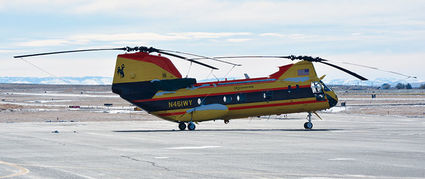Airport Master Plan examines air travel needs
December 23, 2015

Marcus Huff
A Sky Aviation helicopter waits on the tarmac at the Worland Regional Airport. The airport is currently undergoing a master plan survey to recommend improvements and upgrades to the state.
WORLAND – GDA Engineers of Cody held a second Worland Airport Master Plan meeting on Monday at the Worland Airport Terminal focusing on the firm's aviation forecast and the results of an Airport User Survey supplied by GDA earlier this month.
Engineers from GDA were on hand to answers questions and present findings to interested parties.
According to Rick Patton, GDA Principal Planner, an Airport Master Plan is a comprehensive study of an airport that describes short, medium and long-term goals and development to meet future aviation demands. The Federal Aviation Administration (FAA) recommends airports complete an Airport Master Plan every five to seven years to adapt to community changes.
Master plans assess facilities and air traffic, and present a strategy for further development. For Worland, the strategy so far has been to deploy motion-activated cameras to capture air traffic, inventory existing facilities, create future development alternatives, and to finally submit a draft master plan and airport layout to the Wyoming Department of Transportation and the FAA.
As part of the master plan, GDA referenced a 2013 Wyoming Economic Impacts Study to show that the Worland Municipal Airport contributed to 74 jobs, as well as $2,784,780 in annual payroll. The annual economic activity associated with the airport totaled $11,562,280, with additional activities supported by the airport bringing in $446,420 in state and local tax revenue.
GDA Engineers provided an overview of the funding available to airports, highlighting federal funding sources from the FAA's Airport Improvement Program (AIP), such as non-primary entitlement funds and discretionary funds. He also discussed state apportionment funds available to Wyoming airports statewide. He explained that federal funds are derived from user fees. Patton noted that when projects are funded with federal dollars, 90 percent of the costs are covered by the FAA, leaving 10 percent to be split between the state, which pays 6 percent in Wyoming, and the sponsor, in this case the City of Worland, which pays the remaining 4 percent. All state funding is subject to review by the Appropriations Committee in January. "Most of these fees [73 percent], are paid by the passenger when they purchase their ticket," explained Patton. "Your user fee, fuel fee, all of that goes toward this type of funding."
Patton explained that 34 of the 40 airports within Wyoming are funded through the AIP. He then went on to explain the commercial service program and mentioned the EAS. Patton mentioned how the airport is struggling to keep services due to loss of pilots similar to much of the state. In the case of the Worland airport, Patton noted that the facility could use a few improvements, although it is meeting most of the needs of the current users.
According to Patton, the most major improvement to the Worland facility would be an extension of the runway to accommodate the larger corporate jets used by businesses such as Pepsi.
The next step in the Worland Airport Master Plan process is to determine facility requirements and apply them to the FAA's design standards for municipal airports. Three final meetings are to be held in 2016 for public review before the master plan is submitted to WYDOT and the FAA.




